
We will recommend 10 most beautiful places for tourists to visit in Ethiopia.
Ethiopia is a land of stunning landscapes, rich history, and diverse cultures.
Here are the ten most beautiful places:
1. Lalibela, Ethiopia:
2. Simien Mountains National Park:
3. Lake Tana:
4. Gondar:
5. Omo Valley:
6. Axum:
7. Bahir Dar:
8. Harar Jugol:
9. Danakil Depression:
10. Debre Libanos:
1. Lalibela, Ethiopia, Ethiopia:
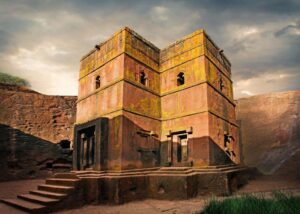
Lalibela is a historically significant town in Ethiopia, renowned for its remarkable rock-hewn churches and rich cultural heritage.
Often referred to as the “New Jerusalem,” Lalibela is a UNESCO World Heritage Site and a major pilgrimage destination for Ethiopian Orthodox Christians.
The town is famous for its 11 monolithic churches, carved directly into the rock in the 12th century during the reign of King Lalibela.
These stunning structures, each with unique architectural features, symbolize the country’s deep religious traditions and showcase impressive engineering skills.
The most famous church, Bet Giyorgis, is not only a masterpiece of medieval architecture but also uniquely carved in the shape of a cross.
Visitors to Lalibela can explore the intricately decorated interiors of the churches, adorned with ancient frescoes and religious artifacts.
The atmosphere is not only spiritually uplifting, but also enriched by daily services and prayers echoing throughout the complex.
The annual Ethiopian Christmas celebration, known as Genna, attracts thousands of pilgrims who come to experience the vibrant ceremonies.
In addition to its religious significance, Lalibela offers stunning natural beauty, surrounded by rugged hills and lush landscapes.
The nearby countryside is perfect for hiking, providing breathtaking views and opportunities to engage with local communities.
Lalibela is not only a historical and religious center but also a vibrant cultural hub, where visitors can immerse themselves in the unique traditions and hospitality of the Ethiopian people.
Overall, Lalibela offers an unforgettable experience, rich in history, spirituality, and natural beauty, making it a must-visit destination in Ethiopia.
2. Simien Mountains National Park, Ethiopia:

Simien Mountains National Park is one of the 10 most beautiful places for tourists, a breathtaking natural wonder located in northern Ethiopia, renowned for its dramatic landscapes, unique biodiversity, and rich cultural heritage.
Designated as a UNESCO World Heritage Site, the park spans over 220 square kilometers and is home to some of the highest peaks in Africa, including Ras Dashen, which reaches 4,550 meters (14,928 feet).
The park’s rugged terrain features not only steep cliffs and deep valleys but also stunning plateaus, making it a paradise for trekkers and nature lovers.
Numerous hiking trails wind through the park, thereby offering spectacular views of the surrounding mountains, as well as the opportunity to encounter diverse wildlife.
Among its notable inhabitants are the gelada baboon, which is unique to the Ethiopian highlands, and the endangered Ethiopian wolf, one of the rarest canids in the world.
Simien Mountains National Park is also rich in flora, with numerous endemic species of plants, including giant lobelias and various flowering herbs.
The changing seasons create a beautiful tapestry of colors, attracting photographers and outdoor enthusiasts year-round.
In addition to its natural beauty, the park is steeped in local culture, with nearby villages showcasing the traditions and lifestyles of the Amhara people.
Visitors can experience authentic hospitality and sample traditional Ethiopian cuisine.
Overall, Simien Mountains National Park offers an unparalleled combination of adventure, stunning landscapes, and cultural experiences.
Whether trekking through its majestic scenery or observing its unique wildlife, a visit to this remarkable park leaves an indelible impression on all who explore its wonders.
3. Lake Tana, Ethiopia:

Lake Tana is Ethiopia’s largest lake, located in the northwest part of the country, and serves as a vital ecological and cultural hub.
Spanning approximately 3,673 square kilometers, it is renowned for its stunning beauty, diverse wildlife, and historical significance.
The lake is particularly famous for its many islands, which are home to ancient monasteries and churches, some dating back to the 14th century.
Notable sites include the island of Dek Island and the monasteries of Ura Kidane Meheret and Kebran Gabriel, where visitors can admire exquisite frescoes and unique architectural styles.
These religious sites are important pilgrimage destinations for Ethiopian Orthodox Christians.
Lake Tana is also a crucial source of biodiversity, hosting numerous bird species, including pelicans and various migratory birds.
The lake’s rich waters are home to an array of fish, making it a key resource for local communities.
The surrounding wetlands not only provide a habitat for diverse flora and fauna, but they also contribute significantly to the region’s ecological health.
In addition to its natural and cultural significance, Lake Tana serves as the source of the Blue Nile River, which flows northward to join the White Nile in Sudan.
This connection underscores the lake’s importance in the broader hydrology of the region.
Visitors to Lake Tana can enjoy boat trips; in addition, they can explore its serene waters and picturesque islands.
The combination of natural beauty, rich history, and vibrant local culture makes Lake Tana a must-visit destination for anyone traveling to Ethiopia.
4. Gondar, Ethiopia:
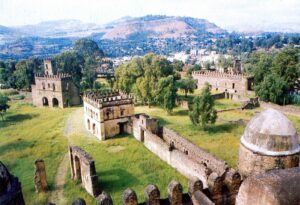
Gondar, often referred to as the “Camelot of Africa,” is one of the 10 most beautiful places for tourists, a historic city in northern Ethiopia renowned for its remarkable castles and rich cultural heritage.
Founded in the 17th century by Emperor Fasilides, Gondar served as the capital of Ethiopia for over two centuries, and today it stands as a UNESCO World Heritage Site, showcasing the country’s unique architectural legacy.
The centerpiece of Gondar is the Royal Enclosure, a complex of castles and palaces, including the striking Fasil Ghebbi, which features intricate stonework and towers that reflect a blend of Ethiopian and European architectural styles.
The grandeur of these structures offers a fascinating glimpse into the lives of Ethiopian royalty and their historical significance.
Gondar is also home to several beautiful churches, such as Debre Birhan Selassie, famous for its stunning frescoes depicting biblical scenes and saints.
The town’s vibrant markets and local cuisine, which feature traditional dishes like injera and doro wat, not only provide visitors with an authentic taste of Ethiopian culture but also enhance their overall experience.
Surrounded by lush landscapes and the Simien Mountains, Gondar is an ideal base for outdoor adventures, including trekking and exploring the region’s natural beauty.
The city is also known for its warm hospitality and rich traditions, making it a welcoming destination for travelers.
Overall, Gondar offers a captivating blend of history, culture, and stunning landscapes.
Whether wandering through its ancient castles or enjoying the local cuisine, a visit to Gondar is an unforgettable experience that showcases the rich heritage of Ethiopia.
5. Omo Valley, Ethiopia:
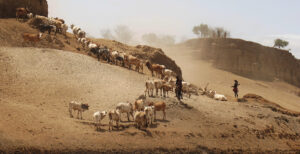
The Omo Valley is one of the 10 most beautiful places for tourists, a captivating region in southern Ethiopia, renowned for its stunning landscapes, diverse cultures, and rich traditions.
This area is home to various indigenous tribes, each with unique customs, languages, and lifestyles, making it one of the most culturally diverse places in Africa.
The valley is characterized by its dramatic topography, with the Omo River winding through lush green hills and arid plains.
The river plays a crucial role in the lives of local communities, providing water for agriculture and serving as a vital resource for wildlife.
Visitors to the Omo Valley can immerse themselves in the vibrant cultures of the tribes, including the Mursi, known for their striking lip plates, and the Hamar, famous for their traditional bull-jumping ceremonies.
Engaging with these communities offers a unique opportunity to learn about their customs, art, and ways of life.
The region is also rich in biodiversity, with numerous national parks nearby, such as Mago National Park and Omo National Park, which are home to various wildlife, including elephants, giraffes, and many bird species.
These parks offer opportunities for trekking, wildlife viewing, and experiencing the natural beauty of the Ethiopian highlands.
For adventurous travelers, the Omo Valley presents a chance to explore a remote and culturally rich part of Ethiopia.
The combination of breathtaking landscapes, diverse cultures, and authentic experiences makes the Omo Valley a must-visit destination for anyone seeking to understand the heart and soul of Ethiopia.
6. Axum, Ethiopia:
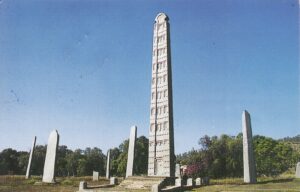
Axum is one of the 10 most beautiful places for tourists, an ancient city in northern Ethiopia, renowned for its rich history and archaeological significance.
Once the capital of the Aksumite Empire, Axum is often considered one of the oldest continuously inhabited cities in the world, playing a crucial role in early Christian history and trade in the region.
The city is best known for its monumental obelisks, which are remarkable stone structures that date back to the 4th century AD.
These obelisks, some of which stand over 20 meters tall, are intricately carved and served as markers for royal tombs, symbolizing the power and wealth of the Aksumite rulers.
The largest obelisk, now partially restored, reflects the architectural prowess of the ancient civilization.
Axum is also home to the Church of St. Mary of Zion, an important pilgrimage site for Ethiopian Orthodox Christians.
It is believed to house the Ark of the Covenant, making it a site of profound religious significance.
The city hosts various religious festivals that draw visitors from around the world.
In addition to its historical and religious importance, Axum offers a glimpse into Ethiopia’s ancient trade routes, connecting Africa, the Arabian Peninsula, and beyond.
The surrounding landscapes, with their rocky hills and fertile valleys, further enhance the beauty of the area.
Overall, Axum is a treasure trove of history, culture, and spirituality, making it a must-visit destination for anyone interested in the rich heritage of Ethiopia.
Its blend of ancient wonders and vibrant culture leaves a lasting impression on all who explore its depths.
7. Bahir Dar, Ethiopia:
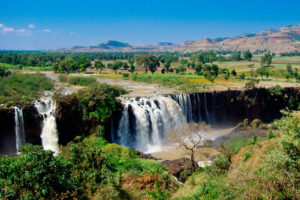
Bahir Dar is one of the 10 most beautiful places for tourists, a picturesque city located on the shores of Lake Tana in northern Ethiopia, known for its stunning landscapes, rich history, and vibrant culture.
As the capital of the Amhara Region, it serves as a gateway to some of Ethiopia’s most significant natural and historical attractions.
One of Bahir Dar’s main highlights is Lake Tana, the largest lake in Ethiopia, which is dotted with over 20 islands, many of which host ancient monasteries and churches.
These include the famous Ura Kidane Meheret, known for its stunning frescoes and historical significance.
Boat trips on the lake offer visitors a chance to explore its serene waters and experience the local fishing communities.
Bahir Dar is also renowned for the nearby Blue Nile Falls, known as Tis Issat or “water that smokes.”
These magnificent falls cascade dramatically into the river below, creating a breathtaking sight, especially during the rainy season.
The city itself features beautiful palm-lined streets, lively markets, and delicious local cuisine, including traditional dishes like injera and doro wat.
Visitors can immerse themselves in the culture by engaging with local artisans and enjoying the vibrant atmosphere of the city.
Additionally, Bahir Dar serves as a base for exploring the Simien Mountains National Park, a UNESCO World Heritage Site known for its stunning landscapes and unique wildlife.
Overall, Bahir Dar is a captivating destination that combines natural beauty, rich history, and warm hospitality, making it a must-visit for anyone traveling to Ethiopia.
Its blend of adventure and culture promises an unforgettable experience.
8. Harar Jugol, Ethiopia:
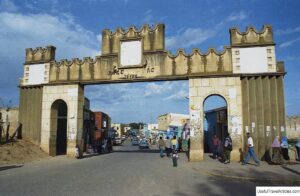
Harar Jugol, the old walled city of Harar, is a UNESCO World Heritage Site located in eastern Ethiopia.
Known as the fourth-holiest city in Islam, Harar is celebrated not only for its rich history but also for its unique architecture and vibrant culture.
Founded in the 7th century, it has long been a center of trade, culture, and religion; thus, it has played a significant role in the region’s development over the centuries.
The city is surrounded by a formidable wall, built in the 16th century to protect it from invasions.
Inside, the narrow winding streets are not only lined with traditional houses but also feature distinctive wooden balconies and colorful facades.
Harar is home to over 80 mosques; moreover, some of these mosques date back hundreds of years, showcasing exquisite Islamic architecture and craftsmanship.
One of Harar’s most unique attractions is its hyena man; in fact, this local tradition involves residents feeding wild hyenas in the evening.
This captivating practice, therefore, draws visitors who are eager to witness the extraordinary interaction between humans and wildlife.
Harar’s vibrant market, known as the Harar Grand Market, is a sensory delight, filled with spices, textiles, and handicrafts.
The city is famous for its coffee, which is a staple of Ethiopian culture; consequently, visitors can enjoy traditional coffee ceremonies in local cafes.
Culturally, Harar is known for its rich traditions, including poetry and music, which reflect the city’s diverse heritage.
The local population includes various ethnic groups, contributing to a dynamic and welcoming atmosphere.
Overall, Harar Jugol offers a unique blend of history, culture, and n
9. Danakil Depression, Ethiopia:
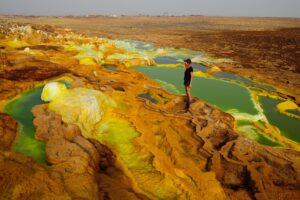
The Danakil Depression, located in northeastern Ethiopia, is one of the most extreme and unique landscapes on the planet.
Renowned for its otherworldly beauty, it is one of the hottest places on Earth, with temperatures frequently exceeding 50 degrees Celsius (122 degrees Fahrenheit).
This geological marvel is a result of tectonic activity and volcanic processes, creating a fascinating environment of salt flats, colorful mineral deposits, and active volcanoes.
One of the most striking features of the Danakil Depression is its vibrant colors, particularly visible in places like the Dallol crater.
Here, sulfur springs and acid pools create vivid hues of yellow, orange, and green, resembling an alien landscape.
The region is also home to Erta Ale, one of the few continuously active lava lakes in the world, drawing adventurers and volcanologists eager to witness its fiery spectacle.
The Danakil Depression is inhabited by the Afar people, who have adapted to the harsh conditions and maintained a unique culture.
Visitors can engage with local communities, learning about their traditional lifestyles and resilience in such an extreme environment.
Despite its harshness, the Danakil Depression offers incredible opportunities for adventure and exploration.
Trekking through its surreal landscapes, witnessing geological wonders, and experiencing the vibrant local culture make it a must-visit destination for those seeking an unforgettable experience.
Overall, the Danakil Depression is a stunning testament to the Earth’s geological forces, offering a rare glimpse into a landscape shaped by extreme conditions and rich cultural heritage.
10. Debre Libanos, Ethiopia:

Debre Libanos is one of the 10 most beautiful places for tourists, a historic and picturesque monastery located about 110 kilometers north of Addis Ababa, Ethiopia.
Founded in the 13th century by Saint Abbo, it is one of the most important religious sites in Ethiopian Orthodox Christianity.
Nestled in the stunning landscapes of the Ethiopian highlands, the monastery is renowned for its breathtaking views of the surrounding valleys and the Blue Nile Gorge.
The monastery complex features beautiful churches adorned with intricate frescoes and ancient manuscripts; consequently, it reflects the rich artistic and spiritual heritage of the region.
The most notable structure is the Church of Saint Abbo, which attracts pilgrims from across the country, particularly during significant religious festivals.
Debre Libanos is also historically significant for its role in the Ethiopian resistance against foreign invasions.
The site has been a center of learning and spiritual guidance for centuries; therefore, it has significantly contributed to the preservation of Ethiopian culture and Christianity.
Visitors to Debre Libanos can enjoy serene walking paths that lead through lush landscapes, offering opportunities for birdwatching and connecting with nature.
The nearby Portuguese Bridge, built in the 17th century, not only provides a picturesque spot for photographs but also serves as an important historical landmark.
The warm hospitality of the local community enhances the experience, allowing visitors to engage with traditional Ethiopian culture.
Overall, Debre Libanos offers a unique blend of spirituality, history, and natural beauty, making it a must-visit destination for anyone exploring Ethiopia’s rich religious and cultural heritage.
Its serene atmosphere leaves a lasting impression on all who visit.
These destinations showcase Ethiopia’s breathtaking natural beauty, rich history, and cultural diversity, making it a fascinating country to explore.




